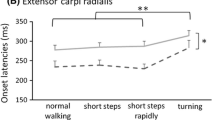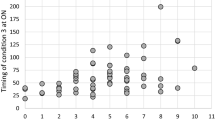Abstract
Freezing of gait (FOG) is an episodic gait disturbance that is commonly seen in Parkinson’s disease (PD). To date, treatment efficacy is limited. We tested the hypothesis that an intervention that utilizes motor learning provided through intensive cueing can alleviate this symptom. Fifteen subjects with PD suffering from FOG participated in a 6 week progressive motor learning program (three training sessions per week—open trial). A training session included FOG-provoking situations (e.g., turns). Prior to each presumed FOG provocation (e.g., just before a turn), rhythmic auditory stimulation (RAS) was elicited and the subject was trained to walk rhythmically, coordinate left–right stepping and to increase step size, utilizing the RAS cueing. Net training duration increased from week to week and secondary cognitive tasks while walking were added to increase FOG propensity. FOG symptom burden was assessed before, immediately, and 4 weeks after the training period. The mean number of FOG episodes (±SEM) per 10 m of walking in a standardized gait assessment decreased from 0.52 ± 0.29 in the pre-testing to 0.15 ± 0.04 in the post-testing (p < 0.05). The duration of FOG episodes decreased from 4.3 ± 2.1 to 2.6 ± 0.6 s (p < 0.05). Additional measures (e.g., FOG questionnaire, gait speed) varied in their responsiveness to the treatment. These effects were retained 4 weeks after the training. The results of this open label study support the possibility that a motor learning-based intervention is apparently effective in reducing FOG burden, suggesting that RAS can deliver ‘anti-FOG’ training.


Similar content being viewed by others
References
Giladi N, Kao R, Fahn S (1997) Freezing phenomenon in patients with parkinsonian syndromes. Mov Disord 12(3):302–305
Giladi N, McDermott MP, Fahn S, Przedborski S, Jankovic J, Stern M et al (2001) Freezing of gait in PD: prospective assessment in the DATATOP cohort. Neurology 56(12):1712–1721
Macht M, Kaussner Y, Moller JC, Stiasny-Kolster K, Eggert KM, Kruger HP et al (2007) Predictors of freezing in Parkinson’s disease: a survey of 6,620 patients. Mov Disord 22(7):953–956
Nieuwboer A, Giladi N (2013) Characterizing freezing of gait in Parkinson’s disease: models of an episodic phenomenon. Mov Disord 28(11):1509–1519
Nutt JG, Bloem BR, Giladi N, Hallett M, Horak FB, Nieuwboer A (2011) Freezing of gait: moving forward on a mysterious clinical phenomenon. Lancet Neurol 10(8):734–744
Hausdorff JM, Schaafsma JD, Balash Y, Bartels AL, Gurevich T, Giladi N (2003) Impaired regulation of stride variability in Parkinson’s disease subjects with freezing of gait. Exp Brain Res 149(2):187–194
Iansek R, Huxham F, McGinley J (2006) The sequence effect and gait festination in Parkinson disease: contributors to freezing of gait? Mov Disord 21(9):1419–1424
Nieuwboer A, Dom R, De Weerdt W, Desloovere K, Fieuws S, Broens-Kaucsik E (2001) Abnormalities of the spatiotemporal characteristics of gait at the onset of freezing in Parkinson’s disease. Mov Disord 16(6):1066–1075
Plotnik M, Giladi N, Balash Y, Peretz C, Hausdorff JM (2005) Is freezing of gait in Parkinson’s disease related to asymmetric motor function? Ann Neurol 57(5):656–663
Plotnik M, Giladi N, Hausdorff JM (2008) Bilateral coordination of walking and freezing of gait in Parkinson’s disease. Eur J Neurosci 27(8):1999–2006
Plotnik M, Giladi N, Hausdorff JM (2012) Is freezing of gait in Parkinson’s disease a result of multiple gait impairments? Implications for treatment. Parkinsons Dis 2012:459321
Bloem BR, Hausdorff JM, Visser JE, Giladi N (2004) Falls and freezing of gait in Parkinson’s disease: a review of two interconnected, episodic phenomena. Mov Disord 19(8):871–884
Sheffield JK, Jankovic J (2007) Botulinum toxin in the treatment of tremors, dystonias, sialorrhea and other symptoms associated with Parkinson’s disease. Expert Rev Neurother 7(6):637–647
Fasano A, Herzog J, Seifert E, Stolze H, Falk D, Reese R et al (2011) Modulation of gait coordination by subthalamic stimulation improves freezing of gait. Mov Disord 26(5):844–851
Stolze H, Klebe S, Poepping M, Lorenz D, Herzog J, Hamel W et al (2001) Effects of bilateral subthalamic nucleus stimulation on parkinsonian gait. Neurology 57(1):144–146
Tommasi G, Lopiano L, Zibetti M, Cinquepalmi A, Fronda C, Bergamasco B et al (2007) Freezing and hypokinesia of gait induced by stimulation of the subthalamic region. J Neurol Sci 258(1–2):99–103
van Nuenen BF, Esselink RA, Munneke M, Speelman JD, van Laar T, Bloem BR (2008) Postoperative gait deterioration after bilateral subthalamic nucleus stimulation in Parkinson’s disease. Mov Disord 23(16):2404–2406
Frazzitta G, Pezzoli G, Bertotti G, Maestri R (2013) Asymmetry and freezing of gait in parkinsonian patients. J Neurol 260(1):71–76
Giladi N, Shabtai H, Simon ES, Biran S, Tal J, Korczyn AD (2000) Construction of freezing of gait questionnaire for patients with Parkinsonism. Parkinsonism Relat Disord 6(3):165–170
Lo AC, Chang VC, Gianfrancesco MA, Friedman JH, Patterson TS, Benedicto DF (2010) Reduction of freezing of gait in Parkinson’s disease by repetitive robot-assisted treadmill training: a pilot study. J Neuroeng Rehabil 7:51
Ustinova K, Chernikova L, Bilimenko A, Telenkov A, Epstein N (2011) Effect of robotic locomotor training in an individual with Parkinson’s disease: a case report. Disabil Rehabil Assist Technol 6(1):77–85
Van Gerpen JA, Rucker CT, Matthews M, Saucier MA (2012) Lifting the “FOG” with laser generated visual-cueing. Neurologist 18(5):298–301
Velik R, Hoffmann U, Zabaleta H, Marti Masso JF, Keller T (2012) The effect of visual cues on the number and duration of freezing episodes in Parkinson’s patients. Conf Proc IEEE Eng Med Biol Soc 2012:4656–4659
Rochester L, Nieuwboer A, Baker K, Hetherington V, Willems AM, Chavret F et al (2007) The attentional cost of external rhythmical cues and their impact on gait in Parkinson’s disease: effect of cue modality and task complexity. J Neural Transm 114(10):1243–1248
Cubo E, Leurgans S, Goetz CG (2004) Short-term and practice effects of metronome pacing in Parkinson’s disease patients with gait freezing while in the ‘on’ state: randomized single blind evaluation. Parkinsonism Relat Disord 10(8):507–510
Mirelman A, Maidan I, Herman T, Deutsch JE, Giladi N, Hausdorff JM (2011) Virtual reality for gait training: can it induce motor learning to enhance complex walking and reduce fall risk in patients with Parkinson’s disease? J Gerontol A Biol Sci Med Sci 66(2):234–240
Hausdorff JM, Lowenthal J, Herman T, Gruendlinger L, Peretz C, Giladi N (2007) Rhythmic auditory stimulation modulates gait variability in Parkinson’s disease. Eur J Neurosci 26(8):2369–2375
Nieuwboer A, Baker K, Willems AM, Jones D, Spildooren J, Lim I et al (2009) The short-term effects of different cueing modalities on turn speed in people with Parkinson’s disease. Neurorehabil Neural Repair 23(8):831–836
Goetz CG, Tilley BC, Shaftman SR, Stebbins GT, Fahn S, Martinez-Martin P et al (2008) Movement Disorder Society-sponsored revision of the Unified Parkinson’s Disease Rating Scale (MDS-UPDRS): scale presentation and clinimetric testing results. Mov Disord 23(15):2129–2170
Nasreddine ZS, Phillips NA, Bedirian V, Charbonneau S, Whitehead V, Collin I et al (2005) The Montreal Cognitive Assessment, MoCA: a brief screening tool for mild cognitive impairment. J Am Geriatr Soc 53(4):695–699
Ziegler K, Schroeteler F, Ceballos-Baumann AO, Fietzek UM (2010) A new rating instrument to assess festination and freezing gait in Parkinsonian patients. Mov Disord 25(8):1012–1018
Nieuwboer A, Rochester L, Herman T, Vandenberghe W, Emil GE, Thomaes T et al (2009) Reliability of the new freezing of gait questionnaire: agreement between patients with Parkinson’s disease and their carers. Gait Posture 30(4):459–463
Morris S, Morris ME, Iansek R (2001) Reliability of measurements obtained with the Timed “Up & Go” test in people with Parkinson disease. Phys Ther 81(2):810–818
Podsiadlo D, Richardson S (1991) The timed “Up & Go”: a test of basic functional mobility for frail elderly persons. J Am Geriatr Soc 39(2):142–148
Peto V, Jenkinson C, Fitzpatrick R, Greenhall R (1995) The development and validation of a short measure of functioning and well being for individuals with Parkinson’s disease. Qual Life Res 4(3):241–248
Powell LE, Myers AM (1995) The Activities-specific Balance Confidence (ABC) Scale. J Gerontol A Biol Sci Med Sci 50A(1):M28–M34
Schaafsma JD, Balash Y, Gurevich T, Bartels AL, Hausdorff JM, Giladi N (2003) Characterization of freezing of gait subtypes and the response of each to levodopa in Parkinson’s disease. Eur J Neurol 10(4):391–398
Lim I, van Wegen E, de Goede C, Deutekom M, Nieuwboer A, Willems A et al (2005) Effects of external rhythmical cueing on gait in patients with Parkinson’s disease: a systematic review. Clin Rehabil 19(7):695–713
Winfree KN, Pretzer-Aboff I, Hilgart D, Aggarwal R, Behari M, Agrawal SK (2013) The effect of step-synchronized vibration on patients with Parkinson’s disease: case studies on subjects with freezing of gait or an implanted deep brain stimulator. IEEE Trans Neural Syst Rehabil Eng 21(5):806–811
Bachlin M, Plotnik M, Roggen D, Giladi N, Hausdorff JM, Troster G (2010) A wearable system to assist walking of Parkinson’s disease patients. Methods Inf Med 49(1):88–95
Bachlin M, Plotnik M, Roggen D, Maidan I, Hausdorff JM, Giladi N et al (2010) Wearable assistant for Parkinson’s disease patients with the freezing of gait symptom. IEEE Trans Inf Technol Biomed 14(2):436–446
Fisher BE, Wu AD, Salem GJ, Song J, Lin CH, Yip J et al (2008) The effect of exercise training in improving motor performance and corticomotor excitability in people with early Parkinson’s disease. Arch Phys Med Rehabil 89(7):1221–1229
Forrester LW, Hanley DF, Macko RF (2006) Effects of treadmill exercise on transcranial magnetic stimulation-induced excitability to quadriceps after stroke. Arch Phys Med Rehabil 87(2):229–234
Liepert J (2006) Motor cortex excitability in stroke before and after constraint-induced movement therapy. Cogn Behav Neurol 19(1):41–47
Petzinger GM, Fisher BE, Van Leeuwen JE, Vukovic M, Akopian G, Meshul CK et al (2010) Enhancing neuroplasticity in the basal ganglia: the role of exercise in Parkinson’s disease. Mov Disord 25(Suppl 1):S141–S145
Petzinger GM, Fisher BE, McEwen S, Beeler JA, Walsh JP, Jakowec MW (2013) Exercise-enhanced neuroplasticity targeting motor and cognitive circuitry in Parkinson’s disease. Lancet Neurol 12(7):716–726
Tripoliti EE, Tzallas AT, Tsipouras MG, Rigas G, Bougia P, Leontiou M et al (2013) Automatic detection of freezing of gait events in patients with Parkinson’s disease. Comput Methods Programs Biomed 110(1):12–26
Acknowledgments
We thank the persons who volunteered to participate for their time and effort, and Dr. Anat Mirelman for her input. This study was funded in part by the Michael J. Fox Foundation for the Research of Parkinson’s disease, and by the European Union—Seventh Framework Programme (FP7/2007-2013) under grant agreement n°288516 (CuPiD project).
Conflicts of interest
The authors declare that they have no conflict of interest.
Ethical statements
This study has been approved by the Human Studies Committee of Tel Aviv Sourasky Medical Center, and has therefore been performed in accordance with the ethical standards laid down in the 1964 Declaration of Helsinki and its later amendments. All persons gave their informed consent prior to their inclusion in the study.
Author information
Authors and Affiliations
Corresponding author
Rights and permissions
About this article
Cite this article
Plotnik, M., Shema, S., Dorfman, M. et al. A motor learning-based intervention to ameliorate freezing of gait in subjects with Parkinson’s disease. J Neurol 261, 1329–1339 (2014). https://doi.org/10.1007/s00415-014-7347-2
Received:
Revised:
Accepted:
Published:
Issue Date:
DOI: https://doi.org/10.1007/s00415-014-7347-2




